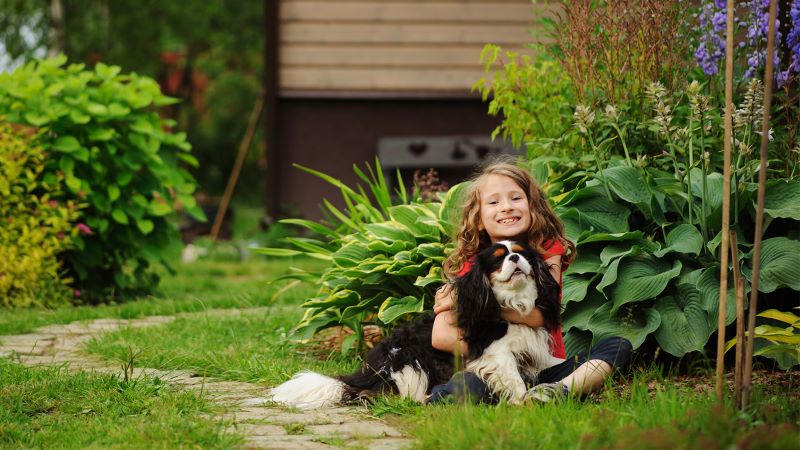Got a little extra time on your hands? While most of us are stuck working from home and/or supervising kids while they complete schoolwork, we may find ourselves ready to pick up a new hobby or devote a little extra time to an outdoor space. How about creating a little garden in your backyard? An oasis you can escape to when you need a break from work or schoolwork? Try our ideas for creating a dog-friendly garden so your four-legged friend can join you in your escape plan!
Start by choosing “paw-friendly” materials.
My kids and I took our dog on a hike recently and had to cross a bridge made of wooden planks. Our poor golden had the toughest time because her paws kept getting stuck in between the planks. When designing your garden, you want to be cognizant of the materials you use. Avoid using materials that will heat up in the sun and burn your dog’s pads. You might try The Kennel Deck which has great reviews for being pet-safe. The deck is made of weatherproof material that is easy to clean and will not heat up in direct sun. Pet parents commented that it drains well, too.
Choose non-toxic plants and flowers for your area.
A rainbow of flowers makes the best decoration. Choose flowers such as zinnias and gerbera daisies, which will not make your dog sick if he accidentally--or on purpose--eats them. This is a great time to plant zinnias and you will be able to enjoy them throughout the summer. Rosemary is also a safe plant to add to your garden. When your dog comes in from playing outside, you will relish the pine scent on his fur. There are many poisonous plants and flowers that you should avoid using in your garden. For peace of mind when it comes to the accidental ingestion of toxic plants, check out an accident and illness pet insurance plan.
Consider adding a digging box.
One of my dog’s favorite “games” to play is to push her ball under the fence around our backyard, and then dig like mad to get to it. We have decided she must be supervised if she has her ball in the yard. But what if she had a designated digging spot? Dog’s brains are hardwired to dig, so how can we get mad when they do it? Similar to a sandbox for human kiddos, try a digging box filled with soil or a sand-soil mix for your dog. If your dog digs outside of the box, be sure to admonish the behavior and lead him back to the digging box. You could even bury some bones or toys in the soil for your dog to dig up!
Beware of dangerous insects.
In the spring, insects come out in swarms and it is important to keep your pet protected. Bites, stings and parasites are all concerns when enjoying the great outdoors! There is nothing to worry about if your pet likes to occasionally catch a moth or grasshopper for a protein-filled snack, but not all insects are safe for your pet. Crickets and grubs can cause worms in your dog, while mosquitos can carry heartworm and fleas have been known to cause tapeworms. Providing your pet with protection against these concerns with flea/tick preventatives and heartworm medication can help keep your pet safe in the long run. By adding a wellness plan to your pet insurance policy, you can even be reimbursed towards these types of preventative treatments!
Provide shelter and water.
While the backyard can be a wonderful escape into the outdoors for some relaxation, it can also heat up pretty quickly. Be sure to provide plenty of shade for your dog and remember that he can get sunburned just like you. An arbor or pergola will keep you and your pooch cool when the weather heats up. You might also consider a doghouse where your dog can catch a nap in the late afternoon.
Remember to bring a fresh bowl of water outside with you whenever you and your dog are spending time in the yard. While a water feature may be a nice way to add interest to your yard design, be sure there is movement in the water to prevent a mosquito breeding ground. Avoid letting your dog drink from non-moving water as this can result in diseases such as Leptospirosis. Leptospirosis is a bacterial infection that can cause your dog to become extremely sick and sometimes leads to liver or kidney failure.
Safe and secure.
Lastly, make sure your garden oasis is fenced in for the safety and protection of your dog. You not only want to keep your dog inside the boundary of your property, you also want to keep dangerous predators out. Allow plenty of space for your dog to run and play but consider planting dog-friendly plants and shrubs around the perimeter of the fence for aesthetic purposes.
So, water you waiting for? Pun intended! Go ahead and get to work on that dog-friendly garden! And if you need ideas on creating the perfect spot for your cat, check out our post, Building a Catio for ideas on making a safe outdoor space for your cat!

